THE
AFFAIR
"14
SUNFLOWERS
YASUDA"
THE
FORGERIES
"VAN
GOGH"
OF
AMEDEE
SCHUFFENECKER
In
the
1930
burst
the
scandal
of
the
"false
Van
Gogh",
culminated
in a
process
concluded
with
the
sentence
of a
merchant
of
art
from
Berlin,
Otto
Wacker,
defendants
of
have
entered
on
the
market
33
forged
paintings.
But
by
now
with
big
irresponsibility,
these
paintings
had
been
inserted
like
authentic
in
the
first
reasoned
catalog
of
the
operas
of
Van
Gogh,
appeared
in
the
1928
care
of
Jacoob
Baart
De La
Faille.
In
fact
for
set
remedy,
in
the
1930,
it
has
been
prepared
a new
catalog
after
a
first
appendix
to
the
first,
entitled
"LES
FAUX
VAN
GOGH",
marked
also
it
unfortunately
from
blatant
limits
and
from
inconceivable
myopia.
Resounding
for
example
the
fact
that
the
DE LA
FAILLE
disposes
in
the
"Paris
period"
(1886-1887)
three
listed
forgeries,
to
the
numbers
77-88-90
of
the
catalog,
clamorously
derived
from
the
two
releases
of
the
12
and
14
Sunflowers
that
VAN
GOGH
had
done
in
the
1888-1889
(and
that,
look
at
case,
they
belonged
both
at
the
end
of
'800
to
the
SCHUFFENECKER
brothers
of
which
we
will
speak
more
ahead).
DE LA
FAILLE
then
expunged
the
tawdrier
forgeries
from
the
catalog
of
the
opera
of
VAN
GOGH,
but
he
didn't
have
the
courage
of
listen
to
and
of
audit
the
importunate
voices,
which
already
circulated
in
those
years
on
magazines
of
German
and
Dutch
art,
which
the
SCHUFFENECKER
brothers
from
Paris
gave
for
sure
counterfeiters,
CLAUDE
EMILE
a
painter,
the
other,
AMEDEE,
merchant
of
wines
and
of
paintings,
collectors
of
the
first
hour
and
already
holders
in
the
first
years
'900
of
about
60
paintings
of
VAN
GOGH,
all
of
excellent
execution,
but
many
of
them
repeated
and
resultant,
the
original
as
well
as
the
duplicate,
of
their
ownership
at
the
same
time.
So it
arrived
the
DE LA
FAILLE,
to
set
it to
himself
if
there
it is
a
clench
connection
among
the
"FALSE
WACKER"
and
the
"FALSE
OF
PARIS
PERIOD",
like
it
results
at
page
25 of
his
catalog
of
false
of
the
1930,
but
he to
this
anxious
question
didn't
know
or he
didn't
want
to
give
response,
also
because
he
already
annotated:
"In
spite
of
the
incontestable
proofs
that
I had
in
the
hands,
I
have
beaten
the
head
against
an
impassable
wall,
format
of
rich
and
powerful
persons,
which
they
have
all
the
interest
to
that
these
mysteries
don't
come
rivealed"
( "Les
faux
Van
Gogh"
page
25).
Well
the
ring
of
conjugation
among
the
two "SCANDALS"
is
represented
surely
from
A.
SCHUFFENECKER.
But
it is
known,
all
the
knots
come
to
the
comb.
And
with
much
probability
today
is
close
to
burst
a new
scandal,
because
an
Italian
expert,
ANTONIO
DE
ROBERTIS,
has
succeeded
after
acute
searches,
to
investigate
on
the
60
operas
possessed
from
the
SCHUFFENECKER
brothers
to
the
beginning
of
the
century,
arriving
at to
the
closure
to
which
it
would
be
been
due
already
arrives
in
the
1930.
It is
that
of
these
60
operas
about
the
half
result
to be
of
the
forgeries.
It is
useless
tell
that
the
DE
ROBERTIS
is
being
met
in
its
actual
searches
with
the
same
conspiracy
of
silence
of
institutions,
critical
and
collectors,
denounced
already
in
the
1930
from
DE LA
FAILLE.
Emblematic
is
the
history
of
four
famous
paintings,
to
couples
legacies
from
a
dark
event,
which
marks
the
destinies:
two
releases
of
the
"14
Sunflowers
on
yellow
bottom"
(YASUDA
and
AMSTERDAM)
and
two
releases
of
the "JARDIN
DE
DAUBIGNY"
with
and
without
the
black
cat (museums
of
Basilea
and
Hiroshima).
All
begins
with
the
first
important
exhibition
of
Van
Gogh
in
Paris,
organized
in
the
Gallery
of
the
brothers
Bernheim
Jeune
in
rue
Laffitte,
from
the
15 to
March
31
1901,
from
a
young
rampant
critical
man
of 31
years
Julien
Leclercq,
partner
in
business
of
Amedče
Schuffenecker,
and
become
mandatary
of Jo
Bonger
Van
Gogh,
widow
of
Theo
Van
Gogh,
for
the
sale
of
the
paintings
of
Vincent
at
the
end
of
the
'800.
This
paradoxical
exhibition
(on
65
exposed
operas
at
least
10
were
false),
consolidate
the
celebrity
of
Van
Gogh
in
the
artistic
paris
milieu
definitely,
but
it
hide
a
sequence
of
trick
cheats
organized
and
tried
from
the
two
Leclercq
partners
and
A.
Schuffenecker
to
the
damages
of
the
widow
Van
Gogh
and
of
some
paris
collectors
, of
which
nobody
till
now
had
noticed
in
100
years.
Why?
Here
the
proofs.
At
the
end
of
the
year
1900
the
widow
Van
Gogh
sends
to
Leclercq
the
"14
SUNFLOWERS
ON
YELLOW
BOTTOM"
(release
now
in
Amsterdam)
probably
for a
restoration.
Immediately
Leclercq,
which
knows
that
of
this
painting
the
widow
possesses
two
releases
of it,
search
with
the
deceit
to
take
possession
of
that
sent
in
Paris.
How ?
Offering
in
change
to
the
widow
(like
it
result
from
a
letter
of 15
April
1891)
probably
the
original
release
of
the "Jardin
de
Daubigny",
(with
black
cat
in
first
plain),
of
ownership
of A.
Schuffenecker,
after
made
a
copy
almost
identical
(without
the
black
cat).
Why ?
Because
the "fourteen
sunflowers
on
yellow
bottom"
interested
to a
paris
collector,
the
Count
Antoine
de La
Rochefoucauld
that
had
arranged
to
pay
it
very
well;
in
fact
in
the
exhibition
of
the
1901
this
painting
comes
presented
already
at
the n.6
of
catalog
as
ownership
of
the
count,
despite
the
widow
Van
Gogh
not
only
doesn't
want
to
sell
it,
but
she
didn't
want
not
even
that
it
comes
exposed;
a
copy
of
this
catalog
(today
registered
in
the
files
of
the
museum
Van
Gogh)
is
sent
the
March
15
1901,
day
of
the
inauguration,
to
the
widow
Van
Gogh,
and
it
has
some
autograph
annotations
of
the
Leclercq;
first
of
all
the
paintings
at
the
numbers
56
and
57 of
catalog,
from
the
title
respectively
"PAYSAGE
DE
PROVENCE"
and "PAYSAGE,"
indicated
like
belonging
to
Duret
Theodore,
famous
critic
friend
of
the
Impressionist,are
annulled
by
pen
and
more
under
with
the
annotation
autograph
of
the
Leclercq:
"Removed
from
the
exhibition
because
not
of
hand
of
Vincent".
This
annotation,
specified
only
to
the
widow,
plays
today
really
strangely.
How
did
Leclercq
to
know
with
certainty
that
in
the
1901
those
two
paintings
were
false?
Which
motive
was
there
in
the
1901
of
adulterate
operas
of a
painter
that
didn't
have
any
market
and
then
were
having
not
value?
They
are
anxious
questions,
but
at
least
a
thing
is
certain,
which
already
in
the
1901
circulated
false
"Van
Gogh".
Then
a
blatant
cancellation
by
pen
just
to
the
number
6 of
the
catalog,
where
Leclercq
corrects:
"Tournesols
sur
fond
jaune"
in
"Verončse",
surely
with
the
intent
of
don't
do
understand
to
the
widow
of
have
exposed
the
"14
Sunflowers
Amsterdam"
without
her
consent
and
doing
therefore
understand
that
it
was
another
painting.
Leclercq
disposed
to
the
lies
and
to
the
cajoleries
(of
this
Paul
Gauguin
was
already
known,
how
it
results
from
many
letters
addressed
to
the
friend
Daniel
de
Monfreid)
like
besides
his
partner
in
business
Amedče
Schuffenecker
was
it,
he
had
probably
already
sold
the
painting
still
isn't
his,
but
still
of
the
widow,
waiting
the
exchange
with
the
count
de La
Rochefoucauld.
To
the
last
moment
the
widow
refused
the
exchange
of
the "JARDIN
DE
DAUBIGNY"
with
black
cat,
putting
Leclercq
offside,
but
he
didn't
want
to
lose
the
business
already
completed
with
the
Count.
What
to
do?
The
two
dishonest
partners
didn't
lose
themselves
of
minds.
They,
at
the
exhibition
concluded,
replaced
in
the
same
baroque
frame,
to
the
place
of
the
"14
Amsterdam
sunflowers",
a
copy
almost
identical,
but a
few
bigger
(done
maybe
in
the
past
years
by
Paul
Gauguin
or by
the
painter
brother
of
Amedče
Schuffenecker),
folding
the
excesses
on
the
loom
removed
from
the
real
painting
to
use
the
same
frame
and
maybe
the
label
of
the
exhibition
of
the "XX"
1890,
to
which
the
painting
had
participated
(with
the
number
4 or
5),
affixed
on
the
horizontal
upper
part
of
the
loom.
The
original
painting
(14
Sunflowers
Amsterdam)
came
then
lengthened
in
the
upper
part
of
three
centimetres
presenting
the
operation
like
effect
of a
restoration
in
the
manner
that
the
widow
doesn't
doubt
the
business
that
her
painting
returned
to
her
climbed
on an
other
bigger
loom
and
of
consequence
on an
other
bigger
frame.
On
the
other
hand
the
count
in
this
way
would
not
have
noticed
any
difference
among
the
two
releases
taking
the
false
copy
to
the
place
of
the
original!
But
something
went
cockeyed,
maybe
because
the
copy
was
not
signed
on
the
vase
"Vincent"
like
the
original
and
the
count
maybe
connected
the
thing
with
the
strange
folding
of
the
edges
of
the
painting
on
the
loom.
At
this
point
the
scandal
should
have
burst.
But
the
count
maybe
preferred
choose
the
street
of
the
implied
compromise,
asking
to
the
two
cheats
to
recover
the
forgery
"14
Sunflowers"
(now
Yasuda)
and
to
replace
it
with
the
"12
Sunflowers"
on
bottom
veronese
green
(now
in
the
museum
of
Philadelphia)
that
Schuffenecker
had
bought
directly
from
the
widow
in
the
March
of
the
1894
and
then
authentic.
Because
this
painting
had
the
same
dimension
of
the
other
"reduced"
forgery
, the
count
lodged
it in
the
same
frame,
without
worry
of
the
tally
in
brass,
although
incongruous,
(it
brought
the
written:
"soleils
sur
fond
jaune").
The
painting
"14
Sunflowers"
false
(Yasuda)
refunded
from
the
count
to
Schuffenecker,
came
laundered
like
authentic
with
opportune
contrivance,
from
the
same
three
years
after.
In
fact
Schuffenecker
brought
it
again
to
the
original
dimensions
101x96,5
from
the
previous
reduced
dimension
92x72
, and
he
presented
it in
sale,
like
anonymous
vendor
to
the
exhibition
of
the "Libras
Esthetique"
in
Bruxelles
in
the
1904.
Also
at
this
time
we
are
in
presence
of
cajolery,
to
the
damages
of
the
editor
of
the
exhibition
Octave
Maus.
In
fact
Amedče
Schuffenecker,
before
send
the
painting
to
the
exhibition,
affixes
a
label
in
the
horizontal
upper
part
of
the
loom,
removes
it
from
an
other
small
painting,
which
had
already
participated
with
the
number
2 of
catalog
to
the
exposition,
always
in
Bruxelles,
beside
the
Association
of
the "XX"
in
the
1891,
with
the
title
"Jardin
d'oliviers".
Why?
Because
so
doing
he
confuses
the
ideas
to
Maus
that,
remembering
that
an
identical
painting
of "Sunflowers"
had
participated
in
the
1890
to
the
7th
exposure
of
the "XX",
he
doesn't
omit
of
annotate
under
the
n.
173
of
the
catalog
with
the
title
"Tournesols"
the
annotation
"Exposition
des
XX
1890"
making
a big
blunder
and
legalizing,
unaware
victim,
a
false
painting
like
authentic
with
so
much
of
pedigree.
Of
the
certainty
of
this
cajolery
today,
to a
distance
of
almost
100
years,
has
stayed,
unique
witness,
the
famous
label
of
the
Pottier
Firm
carriers
from
Paris,
(immortalized
in
the
catalog
of
the
Christie's
sale
of 30
March
1987
of
the
false
painting
for
60
billion
Italian
lira,
at
that
time
the
taller
amount
than
in
all
times
paid
for a
painting).
On it
there
is
written:
"Exposition
de
Bruxelles
- Van
Gogh
154
M.
Schuffenecker."
This
label
could
be
been
behind
one
of
the
two
paintings
of
present
Sunflowers
to
the
exhibition
of
the "XX"
of
the
1890
to
Bruxelles
together
to
other
four
paintings.
But
it
should
have
had
the
N. 4
or 5
and
not
154,
unless
that
have
not
been
added
later
2
ciphers
(on a
headed
invoice
of
the
shop
Perč
Tanguy
dated
the
April
1894,
Andries
Bonger
annotates
that
the
painting
"LES
PEUPLIERS"
had
participated
to
the "XX"
in
the
1890
with
in
number
9).
Almost
it
certainly
was
behind
the
small
painting
"Jardin
of
Oliviers"
that
had
been
presented
with
the
number
2 of
catalog
to
the
exhibition
of
the
1891,
in
Bruxelles.
Well
in
that
number
154
is
the
key
of
the
event.
Among
other
things
this
is a
secret
number
of
catalog
of
the
paintings
of
Van
Gogh,
imprinted
on
the
label
in
the
1891
from
Andries
Bonger,
brother
of
the
widow
Van
Gogh,
when
the
small
painting
came
back
from
Bruxelles;
number
that
A.
Schuffenecker
absolutely
could
not
know
but
in
case
only
to
copy
it;
in
fact
the
label
was
already
existing
in
the
exhibition
of
the
1904,
being
it of
the
1891,
and
then
the
Schuffenecker
signature
is
false
(in
fact
it is
in
the
end
of
the
phrase).
Other
bewildering
fact
is
that
above
this
label
there
is
another
glued
under
a
signature
in
blue
piece
of
chalk
"Schuffenecker",
bridled
between
the
two
labels
like
a
sandwich.
This
was a
warning
understand
to
Maus
to
let
him
understand
that
the
below
label
was
of a
preceding
exhibition
in
Bruxelles;
in
fact
the
Maus
fell
in
the
trap.
The
price
of
sale
of
the
painting
in
the
exhibition
was
already
soaring
for
those
times:
5000
francs
equal
at
the
actual
change
to
25.000.000
of
italian
lira.
But
nobody
fell
in
the
trap
and
Schuffenecker
was
able
to
sell
this
forgery
only
in
the
December
1907
to
the
merchant
of
art
Druetfrom
Paris,
after
that
he
had
presented
it in
sale
in a
fair
of
art
to
the
museum
of
Mannheim
in
the
1907,
with
the
price
of
about
15.000
francs
(75.000.000
of
actual
italian
lira),
like
it
result
from
the
catalog
and
from
a
photo
of
the
room
29 of
that
exhibition;
there
Schuffenecker
presented
14
paintings
of "Van
Gogh"
and I
write
it
among
quote,
because
of
those
14
paintings
a
good
half
was
false,
like
it
result
from
the
painting
in
photo
under
the "Sunflowers"
representing
a
sheaf
of
wheat
and
that
it
has
disappeared
from
the
circulation,
although
it
comes
offered
already
then
to
the
price
of
8.000
francs
(about
40.000.000
of
actual
italian
lira).
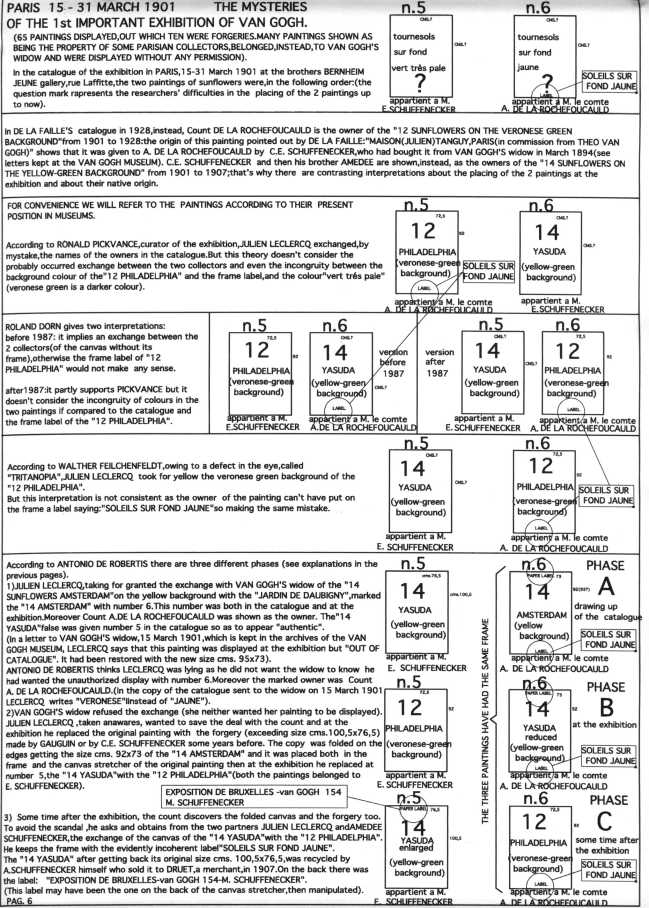
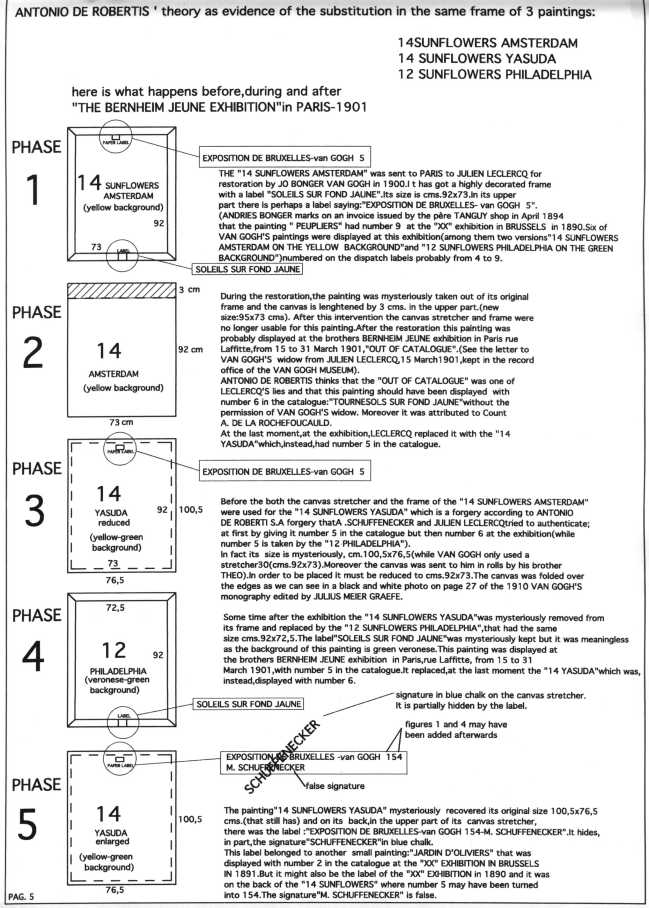
THE
EVENT
OF
"BLACK
CAT"
IN
THE
TWO
RELEASES
OF
THE "JARDIN
DE
DAUBIGNY"
Emblematic
of
the
cajoleries
and
of
the
fraudulent
behaviours
of
the
couple
Leclercq-
Schuffenecker
is
the
event
of
the
two
releases
of
the "Jardin
de
Daubigny".
I
state
in
advance
that
one
of
these
two
paintings
is
surely
a
forgery,
already
submitted
by
some
researchers
to
accurate
analysis,
but
without
that
museum
of
Amsterdam
and
the
official
experts
have
never
been
discoursed.
Recently
putting
this
event
in
connection
with
that
of
the "Sunflowers
Yasuda"
I
have
found
a key
of
very
interesting
reading.
One
of
these
two
releases,
the
original,
had
bought
from
Amedče
Schuffenecker
withdrawing
it
directly
from
the
shop
of
Pčre
Tanguy
where
it
was
in
deposit
for
account
of
the
widow
Van
Gogh,
probably
in
the
March
1894
together
to
the
"12
Sunflowers"
Philadelphia,
and
it
had
in
first
plain
a
black
cat.
We
streak
acquaintance
of
the
existence
of a
second
release,
because
it
has
presented
in
the
exhibition
of
March
1901,
organized
by
Leclercq
beside
the
Gallery
Bernheim
Jeune,
in
the
catalog
to
the
number
18
like
of
ownership
of
the
same
brothers
Bernheim
Jeune.
The
Leclercq
writes
to
the
widow
Van
Gogh
the 5
and
15
April
1901
(registered
letters
deposited
in
the
Foundation
of
the
Museum
Van
Gogh):
"I
have
bought
"the
Jardin
de
Daubigny
" of
Bernheim,
with
the
intent
of
change
it
with
yours
"Sunflowers";
Vincent
has
given
as a
present
a
painting,
at
Auvers,
to
the
Daubigny
family.
The
seconds
has
been
purchased
from
Schuffenecker
in
Tanguy.
It is
the
first
that
I
have,
that
belonged
to
the
family
and
after
gave
to
Vollard,
then
in a
private
collection
sold
after
the
death
of
the
collector,
then
from
Bernheim."
Well
I
discovered
that
Leclercq
lay
to
the
widow
Van
Gogh.
Because
these
passages
of
ownership
were
snide
and
behind
the
anonymous
collector,
after
he
whose
death
the
relatives
had
sold
by
auction
the
painting,
in
March
24
1900
to
the
Hotel
Drouot
of
Paris,
with
the
number
22 of
catalog,
was
hide
the
alive
and
hale
Amedče
Schuffenecker!
( see
the
book
of
Alain
Mothe
"Vincent
Van
Gogh
to
Auvers
sur
Oise"
at
page
118).
Then
from
Amedče
Schuffenecker
passed
both
the
releases
of
these
paintings
at
the
end
of
the
800
like
it
will
be
repeated
other
times
for
other
paintings;
bewildering
it is
the
fact
that
the
release
"purchased"
from
Leclercq
was
surely
the
original
one:
in
fact
this
painting,
in
the
catalog
of
that
sale
from
Drouot
to
the
number
22,
is
described
with
a
"black
cat
in
first
plain"
thing
supported
from
a
photo,
always
on
the
catalog.
Why
never
after
any
time
came
blanked
the
black
cat
from
this
painting,
like
it
results
from
an
observable
stain
to
the
nude
eye
and
from
the x
rays?
How
came
instead
in
the
other
release,
that
for
me is
"false",
after
long
time
from
the
first
drawing
up
have
been
added
contemporary
a
black
cat
and
on
the
right
side
the
written
"Jardin
de
Daubigny"
with
the
same
blue?
It
was
not
certainly
Van
Gogh
to
add
the
cat
here
like
it
was
not
Van
Gogh
to
remove
it
there!
Why?
Because
Van
Gogh
in
the
last
letter
to
Theo
tells
to
have
done
this
painting
around
the
half
July
1890,
that
is 10
days
before
committing
suicide.
How
could
he
have
done
these
additions
and
deductions
to
dry,
on a
painting
so
much
having
material
and
doughy,
it
would
have
employed
weeks
to
dry?
In
the
other
hand
the
"black
cat"
there
was
surely
on
the
original,
like
demonstrated
from
the
description
that
Vincent
does
in
the
last
letter
sent
to
the
brother
before
he
died,
with
an
accurate
draft
enclosed!
Here
there
is
still
the
hand
of
Amedče
Schuffenecker.
Afterwards
the
refusal
to
the
exchange
with
the "Sunflowers"
from
the
side
of
the
widow
Van
Gogh,
to
which
he
had
offered
together
to
Leclercq
the
original
release,
after
he
made
the
copy,
he
removes
the
cat
from
the
original,
for
legalize
like
authentic
his
false
copy,
(that
he
had
painted
without
the
cat),
adding
it in
a
second
time.
This
also
because
Leclercq
in
the
description
on
the
letter
of 15
April
1901
to
the
widow
Van
Gogh
had
confused
a
painting
for
the
other
and
Schffenecker
had
to
take
remedial
measures,
straight
altering
the
sky
and
other
details
of
the
two
paintings.
To
confuse
the
ideas
it
can
also
be
that
they
sent
to
the
widow
the
false
release,
without
the
cat
and
with
colours
diverged
from
the
accurate
description
that
Vincent
did
in
his
last
letter.
She
maybe
becomes
so
suspicious
that
she
renounced
the
exchange.
-------*-------*-------
I
want
to
conclude
this
history,
already
paradoxical,
with
a
trailing
that
brings
us up
today,
which
it
has
the
taste
of a
diabolic
prank:
In
the
1986
the
Foundation
of
the
Museum
Van
Gogh
from
Amsterdam
purchased
a
painting
of
C.E.
Schuffenecker
"Portrait
of
the
Count
A. de
la
Rochefoucauld
or of
Julien
Leclercq".
This
painting
you
will
found
to
the
ground
floor
of
the
museum
Van
Gogh,
entering
the
room
of
the
collection
of
Theo,
just
on
the
wall
in
front.
Well
I do
an
appeal
so
that
this
painting
comes
removed,
because
it is
unworthy
of
have
exposed
it in
the
museum
of
Vincent!
I
will
fight
also
for
this!
Milan,
06
July
1995
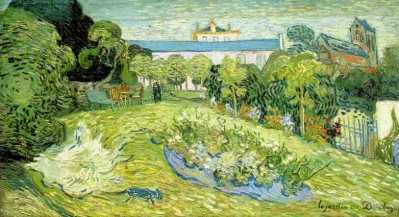

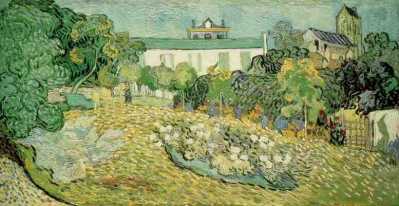
VAN
GOGH
- THE
SOLUTION
OF
THE
MYSTERY
OF
THE
ONLY
SELF-PORTRAIT
WITH
A
FLORAL
BACKGROUND.
ANOTHER
PROOF
THAT
AMEDEE
SCHUFFENECKER
WAS A
FORGER,
FOUND
OUT
BY
THE
ITALIAN
RESEARCHER
ANTONIO
DE
ROBERTIS
In
1904,
JULIUS
MEIER-GRAEFE,
in an
essay
entitled
"ENTWICKELUNSGESCHICHTE
DER
MODERNEN
KUNST",
on
page
328
of "VAN
GOGH
- A
RETROSPECTIVE",
mentioning
VAN
GOGH's
works,
says:
"In
his
painted
portraits
the
wooden
hardnes
of
the
drawing
sometimes
seems
to
become
blended
with
gleaming
metal.
The
master-piece
of
his
self-portraits
is
with
Schuffenecker.
Never
will
anyone
forget
this
enormous
head
with
the
square
forehad,
the
gazing
eyes,
and
the
desoairing
jaw.
A
glistening
piece
of
gold
jewelry
adorn
his
deeply
incised
neckline,
like
a
heathern
symbol.
Below,
tones
of
dark
reddish-blue
sink
into
the
coat
and
next
to
the
harsh
wallpaper
of
the
background
produce
an
effect
like
velvet
caterpillars
on
bare
rocks.
It is
of
such
a
terrible
spendor
of
line,
of
color,
of
psychology
that
it
leaves
one
breathless,
no
longer
knowing
whether
to be
shocked
by
the
grossly
exaggerated
beauty
of it
or by
the
menacing
madness
in
the
face
that
created
it"
Therefore,
the
above
mentioned
painting
has
got a
floral
background
and
in
1904
is to
be
found
in
SCHUFFENECKER's
house,
as it
is
claimed
by
JULIUS
MEIER-GRAEFE.
THIS
IS
THE
PROOF
THAT
AMEDEE
SCHUFFENECKER
WAS A
FORGER.
WHY?
This
painting
was
catalogued
with
n.F.
530
in
1928
by DE
LA
FAILLE
and
reconfirmed
with
n.H.
508
in
1938,
with
the
doubt
that
it
was a
copy
made
by
JUDITH
GERARD,
the
painter,
and
the
step-daughter
of
WILLIAM
MOLLARD.
MOLLARD
was
GAUGUIN's
friend
and
the
painter
had
left
him
some
works
in
1893
and
later.
In
the
catalogue
of
1970,
however,
this
painting
is
excluded
with
n.M.
530
RF.
JUDITH
GERARD
claimed,
in an
interview
to G.
POULAIN
on 10
December
1931
in
the
magazine
"COMOEDIA"
with
the
title
"DANS
LES
MAQUIS
DES
FAUX",
that
she
was
the
author
of
the
identical
copy
of
the
self-portrait
VINCENT
had
donated
to
GAUGUIN
in
September
1888.
She
also
declared
she
had
added
before
the
signature
"VINCENT"
the
word
"d'apres",
and
after
it
her
signature
"JUDITH".
Then,
in
1902,
she
sold
this
copy
to
AMEDEE
SCHUFFENECKER.
In
1908,
while
visiting
an
exhibition
of
VAN
GOGH's
works
that
was
held
at
the
E.
DRUET
Gallery
in
Paris,
JUDITH
GERARD
recognised
her
copy
of
the
self-portrait
displayed
as if
it
were
an
original
work
by
VAN
GOGH.
However
she
noticed
that
the
painting
had
been
modified
in
the
meantime
and
that
there
was
the
addition
of a
new
floral
background
on
the
green
one
she
had
already
painted.
The
word
"d'apres"
and
the
signature
"JUDITH"
had
disappeared
and
only
the
signature
"VINCENT"
had
been
kept.
All
the
modifications
HAD
been
carried
out
by
AMEDEE
SCHUFFENECKER.
Besides,
the
floral
background
of
this
self-portrait
in
the
same
as
the
one
in
the
portrait
of
the
postman
ROULIN,
nowadays
at
the
KROLLER-MULLER
Exibition
in
OTTERLO.
Its
owner,
at
the
beginning
of
the
20th
century,
was
SCHUFFENECKER
and
it
had
been
copied
from
another
painting
with
a
different
background.
This
portrait
of
the
postman
"ROULIN"
is
catalogued
with
n.F.
439
by DE
LA
FAILLE
but
RONALD
PICKVANCE,
in a
lecture
held
in
NEW
YORK
on 17
November
1984,
denied
its
authenticity.
If
the
self-portrait
is a
forgery,
"ROULIN"
is
false
too.
Only
the
author
of
the
floral
background
in
one
of
the
paintings
could
have
done
the
other
one.
This
painter
could
only
be
AMEDEE
SCHUFFENECKER,
the
ower
at
the
same
time,
of
both
the
false
paintings,
and
the
owner,
for a
certain
period,
of
VAN
GOGH's
original
works.
Now,
some
questions
are
inevitable:
why
hadn't
DE LA
FAILLE,
a
scholar
of
the
utmost
integrity,
noticed
that
AMEDEE
SCHUFFENECKER
was a
skilful
forger
in
this
case
as
well
as in
others
? And
why
don't
acknowledged
researchers
such
as
RONALD
PICKVANCE
feel
the
duty
to
find
out
the
truth
after
having
made
such
serious
statements
?
CRONOLOGY
OF
THE
PROVENANCE
OF
THE
ORIGINAL
SELF-PORTRAIT
"BONZO"
AND
ITS
CONNECTIONS
WITH
THE
FALSE
COPY
AND
THE "PORTRAIT
OF
THE
POSTMAN
ROULIN
WITH
A
FLORAL
BACKGROUND"
1888
September:
VINCENT
gives
it,
as a
present,
to
GAUGUIN.
1892
April:
CECILIA
WAERN,
the
American
journalist
of
the "ATLANTIC
MONTHLY",
makes
mention
of it
in an
article
in
the
studio
of
GAUGUIN-SCHUFFENECKER
at
MONPARNASSE.
1893:
it is
kept
in
WILLIAM
MOLLARD's
house
where
his
step-daughter
JUDITH
GERARD,
in
her
teens,
who
had
probably
learnt
to
paint
from
GAUGUIN,
makes
an
identical
copy
that
is
then
sold
to
AMEDEE
SCHUFFENECKER
in
1902.
She
also
says
to
have
sold
the
original
work
to
somebody
sent
by
GAUGUIN
for
300
Francs.
1899:
it is
mentioned
in
the
memories
of
one
of
CLAUDE
EMILE
SCHUFFENECKER's
students
as
part
of
his
collection,
with
one
portraits
of
"THE
POSTMAN
ROULIN".
1901
March:
it
may
be
present
at
the
BERNHEIM
JEUNE
Exhibition
in
Paris,
with
n.1
in
the
catalogue
and
it is
said
to be
owned
by
AMBROISE
VOLLARD.
1904:
JULIUS
MEIER
GRAEFE
points
out,
for
the
first
time,
the
presence
of
the
copy
with
the
floral
background
in
AMEDEE
SCHUFFENECKER's
house.
1905
March:
at
the
21st
Exhibition
"ARTISTES
INDEPENDANTS"
in
Paris,
the
painting:
"LE
POSTIER
HOLLANDAIS"
is
present
for
the
first
time
with
n.40
of
the
catalogue.
This
painting
has
the
same
floral
background
as
the
one
of
the "SELF-PORTRAIT
BONZO",
that
is
owned
by
AMEDEE
SCHUFFENECKER.
March
1996
ANTONIO
DE
ROBERTIS
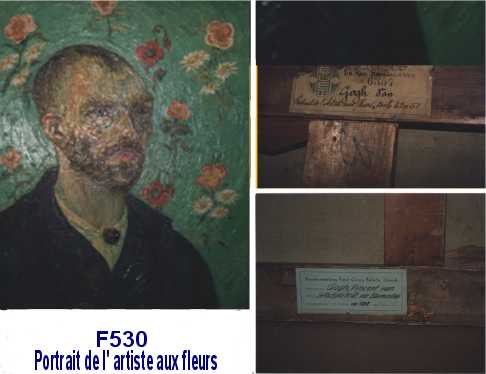
VAN
GOGH
- THE
TRUE
STORY
OF
THE
THREE
VERSIONS
OF
THE
PORTRAIT
OF
THE "POSTMAN
ROULIN"
WITH
FLORAL
BACKGROUND
- A
NEW
ELEMENT
OF
THE
PUZZLE
OF
THE
FORGERIES
MADE
BY
AMEDEE
SCHUFFENECKER.
A
VIRUS
THAT
HAS
DAMAGED
VINCENT'S
WORKS
AS
THE
ITALIAN
RESEARCHER
ANTONIO
DE
ROBERTIS
HAS
FOUND
OUT.
When
VAN
GOGH
died
in
1890
there
were
in
circulation,
al
most
certainly,
5
versions
of
the
"BERCEUSE"
and 4
version
of
the "POSTMAN
POULIN".
But
we
know,
according
to
the
first
catalogue
of
1928
by
DELA
FAILLE,
that
6 "POSTMAN
ROULIN"
were
circulating,
together
with
6
"BERCEUSE",
one
of
which
was
then
excluded
(god
forbid
that
DE LA
FAILLE
should
have
excluded,
by
mistake,
a
true
version
to
replace
it
with
a
false
one.
I
have
some
doubts
about
the
Boston
version
that
was
sold
to
count
A DE
LA
ROCHEFOUCAULD
together
with
the "SELF-PORTRAIT
WITH
THE
BANDAGED
EAR"
and
the "SUNFLOWERS"
almost
certainly
by
one
of
the
SCHUFFENECKERS.
These
three
paintings
are
false
if we
think
that
in
1928,
at
the
birth
of
the
scaldal
of
the
forgeries
of
OTTO
WACKER,
the
count
sold
all
of
them
to
the
PAUL
ROSEMBERG
exhibition
in
Paris).
We
may
think
that
the
cunning
forger
(read
Schuffenecker)
wanted
to "square
accounts"
deliberately.
Wihic
of
the 6
versions
of
the "POSTMAN
ROULIN"
are
the 4
original
ones
and
which
the 2
false
ones?
Let's
try
to
find
out a
logical
answer.
First
of
all i
must
say
that
the
catalogue
of
1970
by DE
LA
FAILLE
is of
no
help.
On
the
contrary
it
confuses
us
since
the
two
paintngs
catalogued
whit
n. F
434
and
n. F
435
have
the
same
origin
and
"look
like
two
parallel
railway
traks
leaaving
from
the
same
station".
That's
rather
unusual
for
two
paintings!
Then
n. F
434,
owing
to
its
yellow
background,
was
taken
for
n. F
435
while
it
should
have
taken
the
place
of n.
F 436
which,
in
its
turn,
should
have
taken
the
place
of n.
F
435.
Let's
proceed
in an
orderly
manner
since
this
case
is
rather
complex
as
always
Amčdče
Schuffenercker
is
involved
with
his
power
of "Damaging"
Van
Gogh's
works.
In
1905,
2 of
the 4
version
of
the "POSTMAN
ROULIN"
belonged
to
the
Van
Goghs
who
displayed
them
at
the
Stedeljik
exhibition
in
Amsterdam
(july
-
august)
as
the
catalogue
says:
415
portret
van
Roulin,
postbeambte
te
Arles
(it
should
be n.
F
434)
443
portret
van
den
brievenbesteller
Roulin
(it
should
be n.
F.
433)
One
belongs
to
Hoogendijk,
the
dutch
collector
dealer
(n.
F.
432)
One
is
displayed
at
the "Salon
des
Artistes
Independants"
21 st
Exhibition
24
march/30
april
1905,
as we
can
see
in
the
catalogue:
Collection
Maurice
Fabre
n. 13
Le
facteur
(su
fond
jaune)
(peinture)
(it
should
be n.
F 435
in
stead
of n.
F 434
!)
This
painting
is
mentioned
in
the
memories
of
one
of
Claude
Emile
Schuffenecker's
students
at
the "Lycče
Michelet
in
Paris.
It is
said
to be
part
of
his
collection
in
1899
but
there
are
no
references
to
the
strange
floral
background,
probably
added
by
Schuffenecker
before
selling
it to
Maurice
Fabre.
Why ?
If we
check
it we
realise
that
there
are
two
other
almost
identical
versions
of
this
portrait:
n. F
436
and
n. F
439.
Their
floral
background
is
anyway
different
and
their
origin
is
not
certain.
Since
it is
rather
obvious
that
to
make
identical
copies
you
need
the
original
painting
i
think
that
the
last
two
are
forgeries
by
Amčdče
Schuffenecker.
He
made
and
commercialized
them
adding
a
floral
background
to
the
original
one
too,
in
order
to
give
more
credibility
to
the
two
forgeries.
Besides
Van
Gogh
never
paintend
versions
of
the "Postman
Roulin"
whit
a
floral
background
nor
of
his
self-portraits.
Schuffenecker
without
being
aware
of
his
habits,
made
the
mistake
to
invent
all
of
them
!
IN
FACT,
IN
1905
THE
FIFTH
VERSION
OF
"THE
POSTMAN
ROULIN"
SHOULDN'T
EXIST
AT
ALL !
How
come
that
in
the
catalogue
of
the
same
exhibition
in
Paris
we
read:
Collection
Amčdče
Schuffenecker
n. 40
le
postier
hollandais
(peinture)
(it
should
be n.
F
439)
A
painting
with
a
strange
floral
background
which
is
also
present
in
the "self-portrait
bonzo"
that
was
seen
by
Julius
Meier-Graefe
in
Schuffenecker's
house
in
1904
?
This
portrait
turned
out
to be
a
forgery
made
by
Amčdče
Schuffenecker.
Himself
modifying
a
regular
copy
executed
before
1902
by
Judith
Gerard
who
had
sold
it to
him
in
good
faith.
THIS
IS A
FURTHER
PROOF
OF
THE
ACTIVITY,
AS A
FORGER,
OF
AMEDEE
SCHUFFENECKER,
A MAN
ABOVE
SUSPICION
BETWEEN
THE
END
OF
THE
19 TH
CENTURY
AND
THE
BEGINNING
OF
THE
20 TH.
THE
PROOF
OF
THE
MISTAKE
IN
THE
CATALOGUE
OF
1970
BY DE
LA
FAILLE
LIES
IN
THE
FACT
THAT
THE
PAINTING
N. F.
434
COULDN'T
HAVE
BEEN
DISPLAYED
AT
THE
SAME
TIME
IN
AMSTERDAM
AND
IN
PARIS
IN
1905
!
IF
"n.
F.
434"
(NOWADAYS
IN
WINTERTHUR)
WAS
IN
AMSTERDAM
AT
THAT
TIME,
THEN
IN
PARIS
THERE
COULD
ONLY
BE n.
F 435
(NOWADAYS
IN
THE
BARNES
A
MERION
COLLECTION)
BECAUSE
ONLY
THESE
TWO
PAINTINGS
HAVE
GOT A
YELLOW
BACKGROUND
!
PAINTING
n. F
435
IN
THE
CATALOGUE
BY DE
LA
FAILLE
IS IN
REALITY
n. F
436
WHICH
DOES
NOT
DATE
BACK
BEFORE
1923.
MOREOVER
IT
NEVER
BELONGED
TO
THE
VAN
GOGHS
AS
ERRONEOUSLY
MARKED
IN
THE
CATALOGUE.
IT IS
TRUE
THAT
FLORAL
BACKGROUND
OF
THIS
PAINTING
IS
THE
SAME
AS
THE
ONE
IN
THE
BOSTON
VERSION
OF
THE
"BERCEUSE",
ONE
OF
THE
THREE
WHOSE
OWNER
WAS
AMEDEE
SCHFFENECKER.
HE
COULD
HAVE
MADE
A
COPY
FROM
THIS
ONE !
ANOTHER
INTERESTING
COSIDERATION
IS
THE
FOLLOWING
ONE:
AFTER
THE
CRISIS
CAUSED
BY
THE
ARGUMENT
WITH
GAUGUIN
IN
1888,
VAN
GOGH
COULD
WORK
VERY
FEW
DAYS
FROM
THE
BEGINNING
OF
JANUARY
TO
THE
BEGINNING
OF
APRIL
1889,
AS
TESTIFIED
BY
THE
LETTERS
TO
HIS
BROTHER
THEO
TOO.
IN
ONE
OF MY
PREVIOUS
STUDIES
I HAD
POINTED
OUT
THAT
IN
THAT
PERIOD
VAN
GOGH'S
ARTISTIC
PRODUCTION
WAS
SUPERIOR
TO
HIS
PHYSICAL
POSSIBILITIES:
20
PAINTINGS
IN
LESS
THAN
20
DAYS.
I
HAVE
FINALLY
DISCOVERED
THAT
AMONG
THESE
20
PAINTINGS
5 ARE
NOT
BY
HIS
OWN
HAND
BUT
BY
AMEDEE
SCHFFENECKER.
MARCH
1996
ANTONIO
DE
ROBERTIS
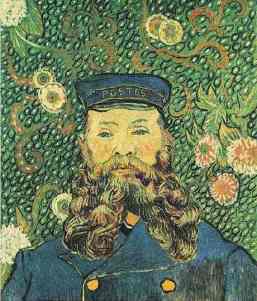
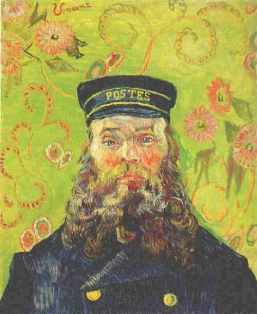
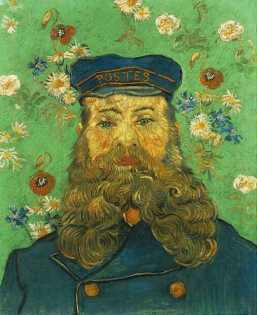
F436 F435 F439
Authentic Authentic, manipulated Probable fake